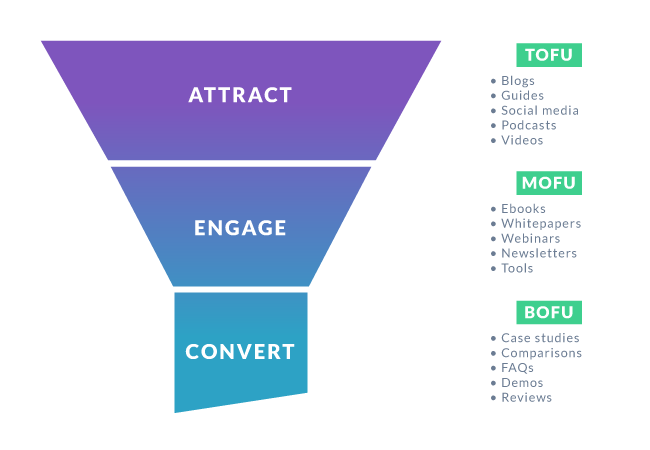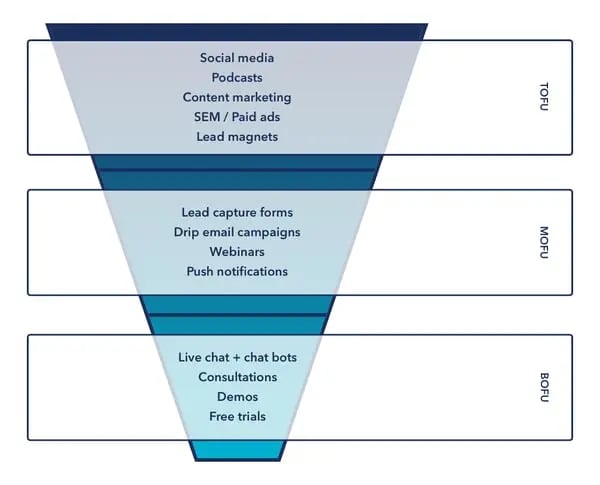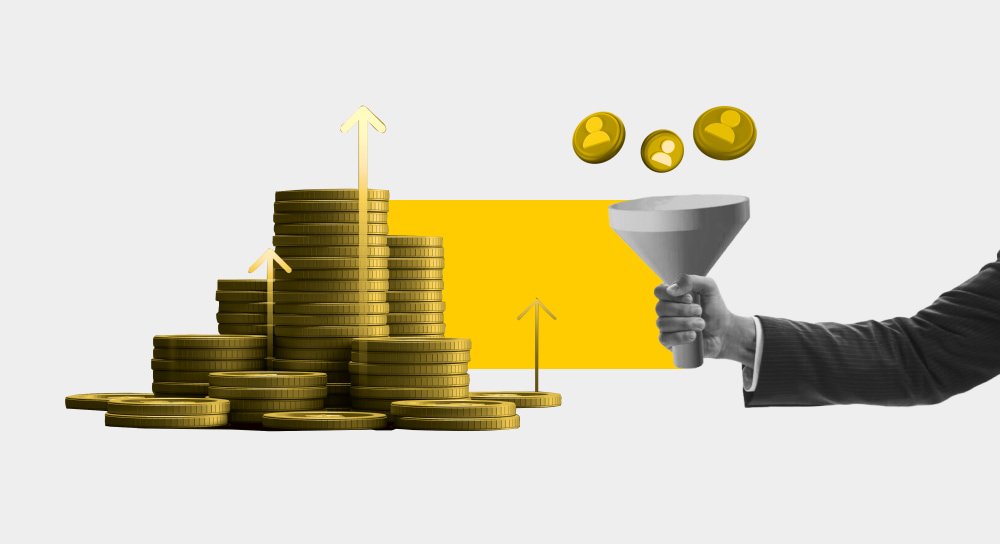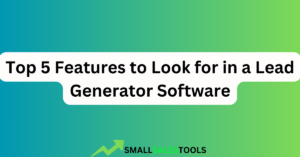A Lead Generation Funnel is a strategic process to attract and convert strangers into interested prospects. It nurtures potential customers through various stages until they are ready to buy.
Lead generation is critical for businesses seeking growth and customer acquisition. The funnel begins with awareness, where potential leads learn about a business or product. It then seamlessly transitions into the interest phase, where engagement and education further pique the prospects’ curiosity.
Consideration follows as leads evaluate the offerings against their needs. The funnel’s final stages include intent, where prospects show interest in purchasing, and conversion, where they become paying customers. Effective lead management and nurturing are essential throughout the funnel to ensure prospects do not drop off and are guided towards making a purchase. By understanding and optimizing each stage of the lead generation funnel, businesses can improve conversion rates and achieve sustainable growth.

Credit: www.ai-bees.io
What Is A Lead Generation Funnel?
Wondering what a lead generation funnel is? It’s a crucial tool that helps businesses turn strangers into buyers. Picture a funnel: wide at the top and narrow at the bottom. This image is key to understanding the lead generation process. It starts broad, attracting many, and then carefully guides potential customers step-by-step towards a purchase.
Definition
At its core, the lead generation funnel is a strategic model. It describes the journey of a potential customer from first hearing about a company to making a purchase. The funnel has multiple stages, each designed to move the lead closer to becoming a customer.
Purpose
The main aim of a lead generation funnel is simple. It exists to turn people who are just finding out about a business into leads. Then, it nurtures these leads until they’re ready to buy. The funnel is carefully crafted to provide value at each step, earning trust and building interest.
Businesses use various strategies within this funnel:
- Content Marketing: To attract and educate.
- Email Campaigns: To nurture and engage.
- Offers: To convert leads into customers.
| Funnel Stage | Strategy | Purpose |
|---|---|---|
| Awareness | Blog posts, social media | Attract visitors |
| Interest | eBooks, webinars | Educate prospects |
| Decision | Case studies, demos | Convince leads |
| Action | Discounts, bonuses | Close sales |
By outlining each stage and strategy, businesses can craft a more effective lead generation funnel. This systematic approach ensures no potential customer is lost along the way.
Stages Of A Lead Generation Funnel
The success of any marketing strategy often hinges on a well-structured lead generation funnel. This pathway guides potential customers from the first inkling of awareness about your product or service right through to the final action of making a purchase. Each stage is crucial in nurturing leads effectively.
Awareness
At the top of the funnel lies the Awareness stage. Here, potential leads encounter your brand for the first time. You want them to notice you, and this requires visibility. Engage users through:
- SEO-optimized content to rank high in search results
- Social media campaigns to attract a audience
- Informative blog posts to address customer pain points
Interest
Once aware, leads move into the Interest stage. Here, you deepen their engagement with your brand. Offer value through things like:
- Email newsletters that provide useful tips
- E-books to educate them on relevant topics
- Interactive webinars
Desire
Creating a Desire for your products or services is key. Transform interest into a real intent to purchase. Do this with:
- Demonstrations of product effectiveness
- Compelling case studies
- Testimonials from satisfied customers
Action
The final section of the funnel, the Action stage, is where leads convert into customers. Encourage this step with strong calls to action, limited-time offers, and streamlined checkout processes.
- Clear and concise CTAs
- Discount codes for first-time purchases
- An easy checkout experience
Creating An Effective Lead Generation Funnel
Begin snippet for ‘Creating an effective lead generation funnel’ section of a blog post
An effective lead generation funnel is a vital tool for business success. It guides potential customers from first hearing about your brand to making a purchase. Crafting a funnel that engages and converts is key. Let’s dive into how to build one that works.
Identify Target Audience
Finding the right audience is step one. Understand who needs your products or services. Use data to pinpoint demographics and preferences. This knowledge shapes your marketing strategy.
Attracting Leads
Once you know your audience, attract them with compelling content. Think blog posts, videos, and social media updates. These should spark interest and drive traffic to your site.
Capturing Leads
You’ve got their attention, now capture it. Use calls-to-action and landing pages. Offer value with free ebooks or webinars in exchange for their contact information.
Nurturing Leads
Lead nurturing is about building relationships. Send regular emails with useful info. Personalize them to show you understand and care about their needs.
Converting Leads
The final step is turning leads into customers. Close the deal with a mix of follow-up emails, special offers, and persuasive copy that highlights the benefits of your product.

Credit: www.leadfeeder.com
Optimizing The Lead Generation Funnel
Turning visitors into valuable leads is an art. Optimizing the lead generation funnel is crucial. It ensures your marketing efforts bear fruit. Here’s how you can tweak and refine your funnel for maximum efficiency:
Analytics And Tracking
Understanding your audience’s behavior is key to optimization. Use analytics to track user actions. This informs where you may lose potential leads.
- Implement tools like Google Analytics.
- Monitor metrics such as bounce rate and conversion rate.
- Analyze traffic to understand which sources bring quality leads.
- Track user journey to pinpoint drop-off points.
A/b Testing
Never assume what works best for your funnel. Test it. A/B tests compare two versions of a webpage to see which performs better. You can test:
- Headlines and subheadlines
- Call-to-action buttons
- Images and videos
- Forms and layouts
Refining And Improving
Continuous improvement is the mantra for successful lead generation. Collect data from analytics and A/B tests. Then refine your funnel.
Follow these steps:
| Step | Action |
|---|---|
| 1 | Identify and fix weak points. |
| 2 | Update content to match user expectations. |
| 3 | Enhance user experience. |
| 4 | Repeat the optimization cycle. |
Challenges In Lead Generation Funnels
Lead generation is a crucial step in building a successful business. It’s like planting seeds for future growth. But challenges can pop up along the way. These hurdles can make or break your lead generation efforts.
Low Conversion Rates
Having lots of visitors but few leads? That’s a low conversion rate. It’s a sign something might not be working right. Maybe the offer isn’t tempting enough, or the sign-up process is too long. It’s important to grab people’s attention and make it easy for them to say “Yes!”
- Call-to-Action: Make it shine and stand out.
- Page speed: Fast loading pages keep people happy.
- Form length: Shorter forms can mean more sign-ups.
Lead Quality
Getting lots of leads doesn’t always mean they’re good ones. High-quality leads are like finding gold. They have a chance to turn into real customers. Make sure the leads match your ideal customer profile.
| Strategy | Benefit |
|---|---|
| Targeting: | Reaching the right audience matters. |
| Content: | Useful content hooks the right people. |
Lack Of Integration
Everything should work together like a team. Sales, marketing, customer service—all should talk to each other. With good integration, tracking leads and helping them grow is a breeze. Make sure tools and platforms connect well.
- Use CRM software that fits with other tools.
- Automate with email systems to follow up fast.
- Sync your data for a clear picture of what works.

Credit: blog.hubspot.com
Frequently Asked Questions Of Lead Generation Funnel
What Is A Lead Generation Funnel?
A lead generation funnel is a strategic process that guides potential customers from initial awareness to the point of conversion. It maps out the journey of turning prospects into leads and ultimately into paying customers, using various marketing tactics to nurture them along the way.
Which Are The 4 Steps Of The Lead Generation Process?
The four steps of the lead generation process are: attracting visitors, converting visitors into leads, closing leads into customers, and nurturing customers for future sales.
What Is A Lead Generation Funnel In Clickfunnels?
A lead generation funnel in ClickFunnels is a strategic process designed to capture and convert prospects into customers, guiding them through stages from initial interest to final purchase.
How Do You Get Leads In A Funnel?
To generate leads in a funnel, create engaging content, optimize landing pages for conversion, use targeted advertising campaigns, implement SEO strategies, and leverage social media platforms. Conduct regular A/B testing to refine techniques and improve lead acquisition.
Conclusion
Crafting an effective lead generation funnel is crucial for any business aiming to thrive online. By tapping into the power of targeted strategies and continuous optimization, you can convert prospects into loyal customers. Remember, the journey doesn’t end at conversion; nurturing relationships is key for lasting success.
Get started, refine your approach, and watch your business grow.




